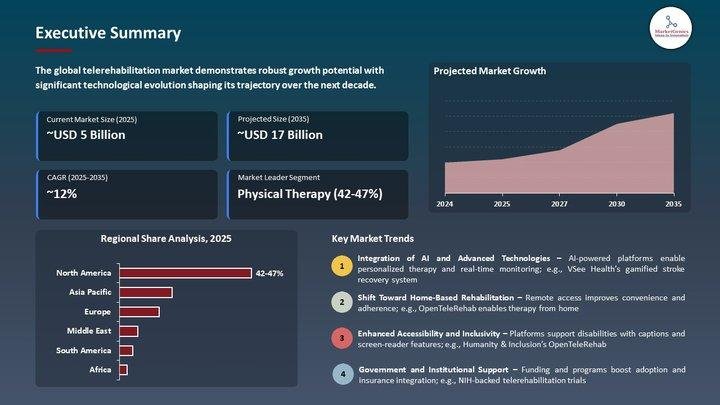
Telerehabilitation Market to Reach USD 17.6 Billion by 2035, Creating USD 12.8 Billion in New Opportunities Driven by AI, Wearable
The global Telerehabilitation Market is projected to grow from USD 4.8 billion in 2025 to USD 17.6 billion by 2035, expanding at a CAGR of 12.5% over the forecast period.
This expansion will generate an incremental opportunity of USD 12.8 billion, driven by AI-powered remote therapy, wearable-integrated monitoring, and the global shift toward home-based and hybrid rehabilitation models.
MarketGenics identifies telerehabilitation as a cornerstone of the post-pandemic digital-care ecosystem, bridging healthcare accessibility gaps while enhancing therapy adherence, clinical outcomes, and operational efficiency for providers worldwide.
Get the Detailed Industry Analysis (including the Table of Contents, List of Figures, and List of Tables) – from the Telerehabilitation Market Research Report: https://marketgenics.co/press-releases/telerehabilitation-market-37132
Recent Developments Shaping the Market
XRHealth Expands VR-Based Telerehabilitation in Asia-Pacific
In April 2025, XRHealth extended its immersive VR rehabilitation platform into Japan and South Korea through hospital partnerships, introducing multilingual modules for post-stroke and orthopedic recovery.
Philips Healthcare Launches AI-Enabled Virtual Care Station
In 2024, Philips Healthcare deployed its AI-driven virtual station to enable remote assessment for chronic conditions such as COPD and stroke, accelerating the adoption of connected rehabilitation ecosystems.
VSee Health Advances AI-Gamified Stroke Recovery Trials
In June 2025, VSee Health initiated Phase 3 trials of its AI-powered gamified telerehabilitation platform, supported by NIH funding, targeting improved therapy adherence and enhanced reimbursement frameworks.
Humanity & Inclusion Upgrades OpenTeleRehab Accessibility
In May 2025, Humanity & Inclusion integrated screen-reader support and automated multilingual captions into its OpenTeleRehab platform to align with WHO-ITU accessibility standards.
Telerehabilitation Market Forecast 2035
The global telerehabilitation market is expected to create an additional USD 12.8 billion in value between 2025 and 2035.
North America remains the most attractive and mature region, driven by digital-health infrastructure and reimbursement support.
Europe and Asia-Pacific are emerging growth centers, propelled by AI adoption, hybrid rehabilitation models, and post-acute care digitization.
Middle East, Africa, and South America are entering early-stage adoption through cost-effective cloud-based and mobile-therapy platforms.
By 2035, telerehabilitation will form an integrated continuum of virtual physiotherapy, cognitive therapy, and speech-language therapy across both hospital and home-care settings.
To know more about the Telerehabilitation Market – Download our Sample Report: https://marketgenics.co/download-report-sample/telerehabilitation-market-37132
Key Drivers, Challenges, and Opportunities
Driver – Aging Population and Mobility Constraints
An expanding geriatric population suffering from arthritis, stroke, and orthopedic limitations is fueling demand for home-based rehabilitation. Platforms such as Reflexion Health’s VeraHome system use motion-sensing avatars for real-time recovery guidance, reducing hospital dependency and improving continuity of care.
Restraint – Lack of Standardized Protocols and Data Security Concerns
Regional disparities in telehealth regulations and inconsistent clinical standards hinder large-scale adoption. Companies like Motus face regulatory barriers due to differing medical-device approval paths and stringent privacy requirements under HIPAA and GDPR-style frameworks, affecting commercialization timelines.
Opportunity – Integration with Wearables and IoT
Merging telerehabilitation with wearable technologies enables real-time feedback and adaptive therapy. In 2024, SWORD Health introduced Digital Therapist+, blending motion sensors with AI algorithms to monitor progress and personalize treatment remotely, significantly improving adherence and outcomes.
Trend – Hybrid Rehabilitation Models Post-COVID
Post-pandemic healthcare evolution has normalized hybrid care models combining in-person assessment and remote therapy. RehabGuru’s 2024 collaboration with NHS Trusts demonstrated how hybrid frameworks raise compliance and patient satisfaction while easing provider workloads-now a blueprint for global adoption.
Segmental Insights
Physical Therapy Dominates with 44% Share
Physical therapy remains the largest therapy type, accounting for ~44% of the global market, owing to its broad use in musculoskeletal disorders, post-operative recovery, and sports injury management. Platforms like Hinge Health leverage AI-based motion tracking to improve recovery speed and engagement.
AI and Advanced Technology Integration Accelerates Adoption
AI-enabled telerehabilitation platforms offering personalized programs and real-time analytics are boosting patient outcomes and retention. These advancements are transforming rehabilitation from a manual clinical process into a data-driven, adaptive model of care.
Buy Now: https://marketgenics.co/buy/telerehabilitation-market-37132
Regional Highlights
North America:
Leads the market through strong telehealth infrastructure, advanced reimbursement frameworks, and widespread clinician acceptance. AI-based orthopedic care and computer-vision-assisted rehab are rapidly expanding home-based treatment options.
Europe:
Adopting hybrid and AI-driven models to enhance long-term patient care while aligning with strict data-protection standards and healthcare digitization strategies.
Asia-Pacific:
Experiencing rapid growth fueled by healthcare digitalization, rising chronic disease incidence, and initiatives like XRHealth’s 2025 regional expansion, reflecting surging institutional demand for virtual therapy systems.
Middle East & Africa:
Early adoption supported by mobile-first digital-health programs and cost-efficient remote-care frameworks for underserved regions.
Competitive Landscape
The telerehabilitation market is moderately fragmented, with the top five players-Hocoma, Kaia Health, MedBridge, Physitrack, and FitMi (Flint Rehab)-commanding over 63% of total market share in 2025.
Tier 1 leaders focus on advanced VR, AI, and motion-tracking platforms, while Tier 2 players such as Reflexion Health and RecoverX specialize in niche and localized rehabilitation systems. The market’s innovation pulse is maintained by continuous software upgrades, AI integration, and clinical validation partnerships.
Future Outlook
By 2035, telerehabilitation will evolve into a digitally synchronized rehabilitation ecosystem, where AI, IoT, and immersive technologies converge to deliver precision therapy at scale.
Key growth vectors include:
Real-time, AI-guided remote physiotherapy
Wearable-integrated patient monitoring
Cloud-based data analytics for outcomes optimization
Hybrid rehabilitation programs spanning physical and cognitive recovery
This convergence of technology, accessibility, and patient-centric care will position telerehabilitation as a foundational pillar of the global digital-health economy-where remote recovery is not an alternative, but the default.
Get a preview of our Telerehabilitation Market Playbook – your guide to GTM strategy, competitive intelligence, supplier dynamics, and Consumer Behavior Analysis: https://marketgenics.co/playbook/telerehabilitation-market-37132
Prominent Companies Operating in the Global Telerehabilitation Market:
Hocoma; Kaia Health; MedBridge; Physitrack; FitMi (Flint Rehab); XRHealth; Philips Healthcare; VSee Health; Humanity & Inclusion (OpenTeleRehab); SWORD Health; RehabGuru; Reflexion Health; RecoverX; Motus; Hinge Health; and other key players.
About Us
MarketGenics is a global market research and management consulting company empowering decision makers across healthcare, technology, and policy domains. Our mission is to deliver granular market intelligence combined with strategic foresight to accelerate sustainable growth.
We support clients across strategy development, product innovation, healthcare infrastructure, and digital transformation.
Contact:
Mr. Debashish Roy
MarketGenics India Pvt. Ltd.
800 N King Street, Suite 304 #4208, Wilmington, DE 19801, United States
USA: +1 (302) 303-2617
Email: sales@marketgenics.co
Website: https://marketgenics.co
This release was published on openPR.












